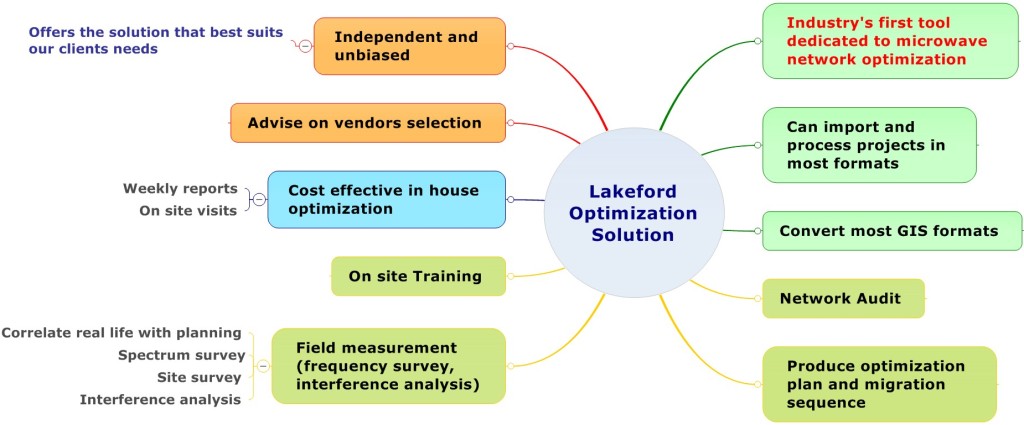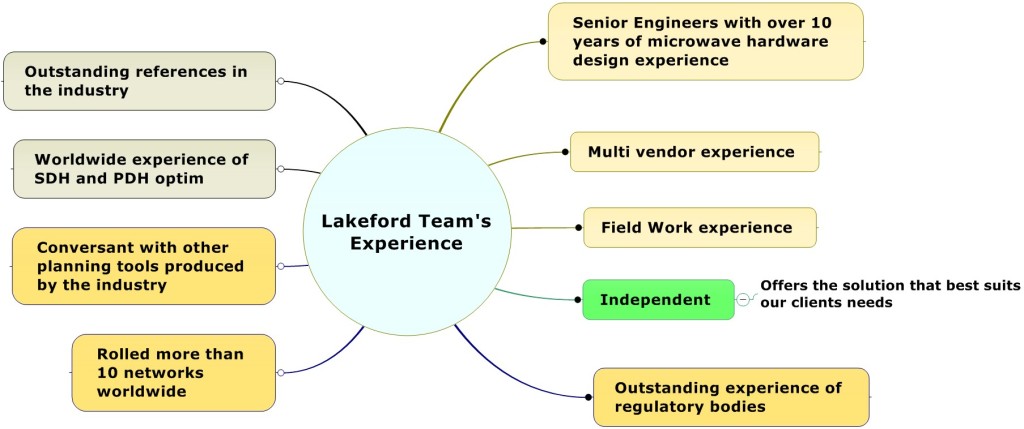Consultancy Services
Microwave Link Networks Optimization Services
WHY OPTIMIZE ?
Recent Transmission infrastructure evolutions have some consequences; let’s mention a few of them concerning our domain of expertise:
-
Microwave Link Transmission Networks deployment and running costs might represent up to 25% of the total of the project’s expenditure.
-
A substantial portion of this amount goes to licensing and regulatory fees.
-
When capacity upgrade is needed, Microwave Link Transmission backhaul are often the bottleneck.
-
3G / WCDMA/HSPA, WiMAX and other high performance wireless services call for drastically higher bandwidth than GSM/EDGE.
-
Migration to the latest services involves substantial changes in the architecture as well as recovering bandwidth

Besides solving those issues would have some positive consequences:
-
Microwave Link Network optimization demonstrates to the regulatory body, the willingness of an operator to make the most efficient use of allocated spectrum therefore improving his chances of obtaining further frequencies.
-
When combined with technology upgrade (e.g. migration to Evolution), Microwave Link Network optimization will be very effective in reclaiming spectrum
-
Microwave Link Network optimization opens new prospects to vendors.
It is desirable to optimize Microwave Link Transmission Networks to recover capacity; our experience shows that an average of 32% of spectrum can usually be recovered through a combination of:
-
Architecture optimization
-
Frequency optimization
-
Routing optimization
LET’S OPTIMIZE
1- ARCHITECTURE OPTIMISATION
Transmission networks are usually rolled out in a hurry: as the coverage increases new links are usually “stacked” over the old ones. The result is inefficient and messy architectures that should be revised. Upgrading the transmission networks to support the capacity increases, needed by the newest radio technologies and services, is the occasion to proceed to a thorough revision of the microwave transmission network architecture.
Architecture optimization will get rid of redundant links through new connectivity (mature networks often have documented Line Of Sight matrices, that allow for quicker changes in connectivity).
The recovered microwave links shall be redeployed in lower density areas, and new high capacity and more spectrum efficient links will be deployed to replace them as required.
Architecture optimization will alleviate intra network interferences, and will allow more efficient frequency reuse, hence more capacity per unit of area.
2- FREQUENCY OPTIMISATION
Frequency optimization encompasses spectrum reorganization and channel prioritization to increase frequency reuse.
To begin with, it is necessary to identify the under-dimensioned microwave links that would need to be upgraded and replaced by higher capacity more spectrum-efficient links. Bearing in mind that the decision to upgrade a link is weighted against:
-
Spectrum fees charged to the operating link
-
Return on investment of the already existing link, as opposed to the replacement link, in function of the network prospects
-
Identification of punctual hardware changes, such as antennas that would allow to lower interference level.
Propagation models could be reviewed to take into account local atmospheric and radio meteorological data when available. The Grade of Service (Quality and Availability as per ITU recommendations) should be assessed for each microwave link as a function of the link usage (capacity, redundancy level, link class). This being done each link transmitted power shall be adjusted to the bare minimum needed to achieve the set GoS, in this manner the interferences will be minimized and it will be possible to achieve bigger frequency reuse while maintaining interferences to an acceptable level.
We will assist the client in the definition of planning, and engineering guidelines, and will produce tailor made reference manuals, based upon latest ITU standards and the transmission network architecture.

3- REROUTING OPTIMISATION
In producing detailed routing plans, and reviewing the current design, we shall insure that the payload is routed in the most efficient manner, through the shortest route, in view of avoiding redundant use of microwave links. Timing and synchronization distribution for SDH network is also part of the rerouting optimization process.
WHO, WHEN and WHERE
1- ASSESSMENT PHASE
Our project leader will ascertain on- site, the client’s needs, audit the network and collect the information required to proceed to the optimization work. The objectives and planning criteria will be reviewed with the Client and revised engineering guidelines, specific to the operator’s needs, shall be defined.
2- STUDY PHASE
Networks description and simulation with the PEGASUS software tool as well as network optimization shall be conducted in our premises. Conducting those labor intensive works at home allows reducing costs significantly by comparison with locally based consultants. When necessary, punctual on-site missions will be organized to assess technical issues and discuss options.
3- IMPLEMENTATION PHASE
On site implementation of the found and agreed upon solutions shall be sequenced to achieve minimal downtime. We will participate closely and several on-site missions should be considered.
4- ON-SITE TRAINING
During the Study and Implementation period, on-site training courses could be delivered to the local crews on microwave link planning and network optimization. See standard training program on the Training Services page of this site. To that program, we could add courses on cost analysis, business models for regulatory fees and radio equipment management. The training being made in the heat of the network upgrade period, it is obvious that the trainer will be subjected to numerous practical questions from the trainees and those latter will be particularly motivated.
WHY Lakeford Consultants
We are seasoned radio engineers with a long experience in telecoms and particularly:
-
20 years of microwave design
-
17 years of experience dealing with regulatory bodies, conversant with regulatory procedures, spectrum management and ITU recommendations
-
Rolled out over ten large networks, worldwide
-
Long experience of SDH and PDH optimization including Live network optimization
-
attentive to the customer’s needs: custom designed solutions
-
References in the Industry: SFR, Bouygues, Orascom, Lucent, Torch Broadband, Winstar, Wataniya, etc… (more details available on request)
-
In house planning tool software leading to very efficient support and short reaction time to support, implement or adapt optimization tool features.
We offer a unique dedicated powerful optimization tool loaded with specific functions that will allow to:
-
Easily Import networks from other planning tools, in various formats
-
Sort out microwave link networks per band, to minimize interference calculation time
-
Efficiently allocate and prioritize channels, as per a pre-defined plan
-
Advanced IRF masks, and radio performance databases covering all ETSI compliant radios, as well as unknowns models through the use of notional equipments used by regulatory bodies.
-
State of the art propagation models, will allow for accurate performance calculation and power settings.
-
Highly flexible in term of terrain models usage: will accept/convert most formats available.
-
Highly experienced and dedicated team that will closely follow step by step the implementation of the optimization solution.
-
Unique Hybrid solution: one part of the work is done locally, whilst calculations and modeling are done remotely hence lower costs (saving around 4,500 Euros in accommodation and living allowance per engineer, per month).
Permanent link to this article: https://lakeford-consultants.com/microwave-link-consultancy/



